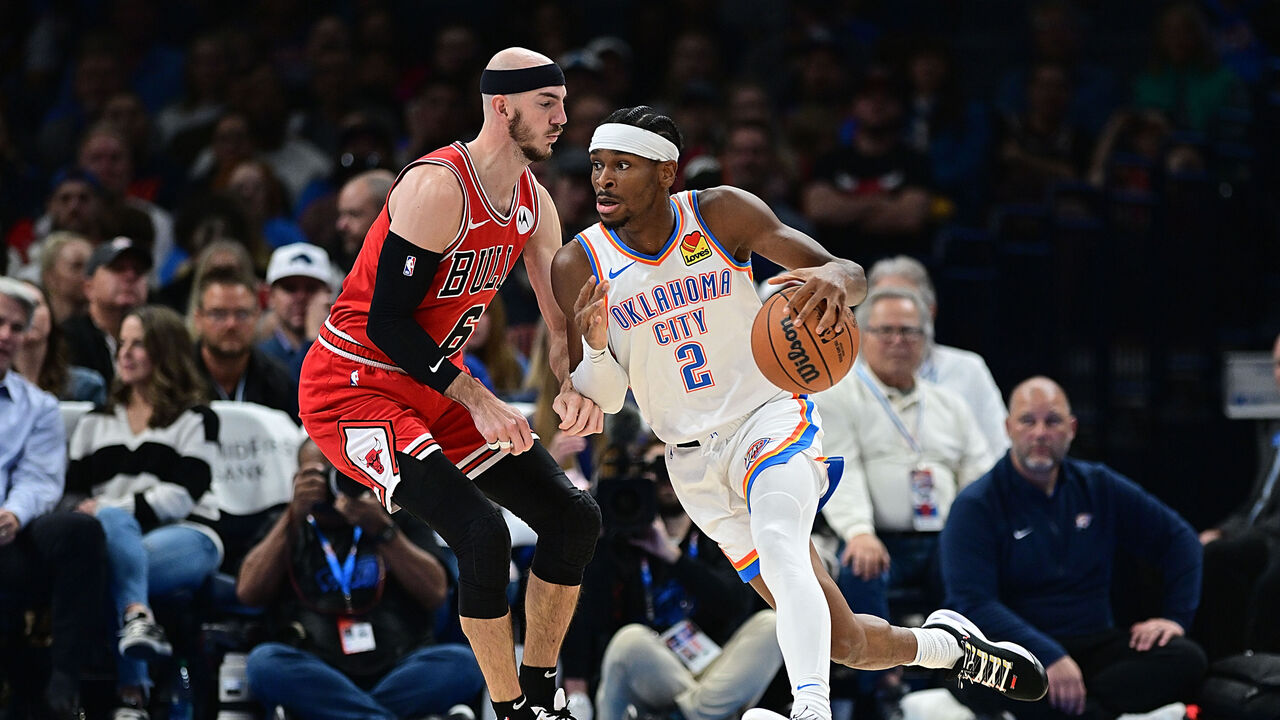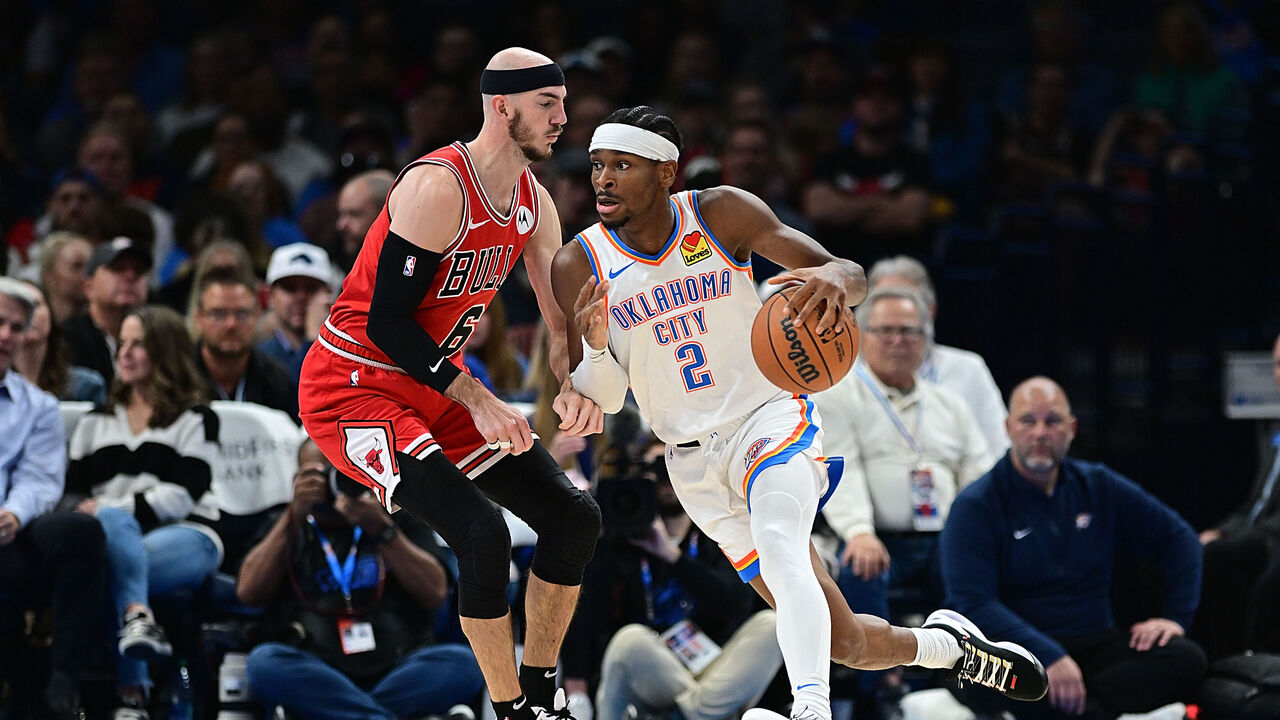How the Thunder can complete their championship puzzle
Before we talk about the Oklahoma City Thunder’s offseason, which already began with a bang, let’s establish something: This team doesn’t necessarily need to do anything further to win the 2025 NBA championship.
The Thunder are coming off a season in which they won 57 games, posted the league’s second-best net rating behind only the title-winning Celtics, became the youngest team ever to finish as a conference’s No. 1 seed, and came within a hair’s breadth of forcing a Game 7 at home against the eventual West champs in the second round of the playoffs.
Their best player is a 25-year-old who just finished runner-up in MVP voting. Their second- and third-best players are 23 and 22, having garnered All-Star consideration in their sophomore and rookie seasons, respectively. Internal development is only going to make them more dangerous. So will exchanging their most problematic starter in Josh Giddey for a veteran role player in Alex Caruso who fits their identity to a T.
All that said, the Thunder still have clear areas where they can stand to improve via external help. And with the option to carve out close to $40 million in cap space, on top of being armed with one of the most stocked draft-asset arsenals in NBA history, they have every possible means of making those improvements. The question is what type of player(s) they should be targeting to complete their championship puzzle.
Let’s start by looking at where Caruso helps them most, and where his acquisition still leaves them wanting.
The biggest and most obvious upgrade he represents is on defense, where OKC already ranked second in the NBA in points allowed per possession this past season. Giddey brought good positional size as a 6-foot-8 guard but was limited by poor lateral agility, a neutral wingspan, and below-average strength. Caruso, meanwhile, might be the best point-of-attack defender in basketball. He’s three inches shorter than Giddey with a similar lack of length, but his strength and balance give him more functional size, with the ability to lock down four positions while providing elite paint deterrence as a nail helper and low man.
He also has some of the fastest and stickiest hands in the business, which means he’ll add a slew of additional deflections and takeaways to a team that just finished top-two in both categories. A starting lineup featuring Caruso, Shai Gilgeous-Alexander, Jalen Williams, Lu Dort, and Chet Holmgren is a freaking bear trap that can ensnare opponents with any conceivable coverage: switching, blitzing, dropping, lock-and-trailing, zoning, full-court pressing, you name it.

Caruso can also provide an offensive upgrade, despite lacking Giddey’s skill as a ball-handler and, especially, as a passer. Because the Thunder are set for shot creation anyway with Gilgeous-Alexander and Williams, Giddey’s on-ball skills never mattered as much to them as Caruso’s superior off-ball skills will. Giddey’s shooting struggles made him borderline unplayable in that second-round series against Dallas as the Mavs cross-matched their centers onto him, kept those centers parked in the lane, and dared him to make them pay. (Narrator: He couldn’t.)
Caruso has never been a high-volume 3-point shooter, and his percentages have fluctuated wildly from season to season, but he nets out at 38% for his career after a season in which he hit 41% from deep. His inconsistency and occasional reluctance mean he’ll likely see his share of center cross-matches as well, but he’s a better bet to make that coverage untenable for opposing defenses. That’s true not only because he can knock down more of his open shots, but also because he’s a better screen-and-rolling guard than Giddey, having grown comfortable on that end of inverted ball-screen actions with DeMar DeRozan in Chicago and LeBron James in Los Angeles. Additionally, Caruso’s proclivity for live-ball turnover generation will further fuel the Thunder’s killer transition attack.
Now, as to those lingering weaknesses…
One place OKC might be negatively impacted by the Giddey-for-Caruso exchange is on the glass, where Giddey was one of the better rebounders (to damn him with faint praise) for a team that ranked 29th in overall rebound rate. That’s one of the most profound ways the team felt its lack of frontcourt size beyond Holmgren (with basically no true power forwards in the rotation), though certainly not the only way. In truth, the rebounding issue didn’t burn the Thunder as badly in the postseason as it seemed like it might, in large part because they counteracted it with a gargantuan turnover advantage that led to them handily winning the possession battle on balance.
Their defense held up just fine in the playoffs; it was their offense – which mustered just 110.9 points per 100 possessions, down from 118.3 during the regular season – that let them down in the end. That drop-off owed largely to some shooting struggles that Caruso will help address, but also to the aforementioned size deficiency that he will not. OKC really struggled to convert at the basket, especially against a Dallas defense that boasted a ton of length and had its centers playing a one-man zone around the rim.
The Thunder, for all their relentless dribble-driving, lacked the kind of imposing presence who could consistently finish through or over that length. Trying to invert spacing with Holmgren on the perimeter and a guard or wing in the dunker spot didn’t help matters. Going from Giddey to Caruso certainly doesn’t hurt in that regard – Giddey’s always been a poor finisher, and Caruso’s shooting gravity might clear some obstacles out of the paint – but it feels like OKC is still a big body short.
And while it makes sense to target a center who can play 15-18 minutes a game and alongside Holmgren situationally (a la Andre Drummond), the bigger focus for Sam Presti and Co. in the size hunt should be adding a legit power forward. Holmgren’s offense is infinitely more valuable at the five, and he showed as a rookie that he’s plenty capable of anchoring the back line of an elite defense. Sure, some of the team’s rebounding issues fell on him and his slender frame, but just as much blame lay with his teammates for failing to corral misses behind him when he contested shots or switched out on the perimeter. It would be super helpful to have more size behind him, and all the better if that additional size doesn’t compromise the team’s five-out offensive concepts.
There’s a reason I (and others) became fixated on the idea of the Thunder paying out the nose for Lauri Markkanen last season. Imagine what it would mean for them to add another 7-footer who can rebound, score inside, hold his own on defense, and shoot the leather out of the ball. The problem is hardly any guys in the league fit that description, and Markkanen might not be available. There’s likewise only one Aaron Gordon (a very different type of four, but one who could be comparably impactful for this team while addressing a slightly different set of issues), and he isn’t going anywhere.
In other words, it’s one thing to point out the type of player the Thunder need most and another to identify an attainable player in that mold. Paul George would fit the bill if OKC could lure him back as a free agent (and how delicious would that be as a capstone to an already lopsided trade?), but that feels pretty unrealistic. As does prying OG Anunoby away from the Knicks. Jerami Grant ticks a lot of boxes, except maybe the one that matters most to OKC, given that he’s one of the worst rebounders for his size in the league. (His contract would also be unpalatable to the front office.)

Deni Avdija would be a fascinating fit if Washington could be talked into moving him. He’s a playmaking four who plays kickass multi-positional defense, made a huge leap as a 3-point shooter (37%) last season, shot 70% at the rim on 86th-percentile volume, and is on a steal of a contract for the next four years. Unfortunately those are also all reasons why the Wizards will be disinclined to trade him. Jonathan Isaac’s health is a huge concern, but his upside would make him worth the risk if the Magic were open to a deal.
Even if they can’t find the ideal power-forward fit, there are plenty of different avenues that can prove fruitful for the Thunder because of how close they already are to their ultimate goal. A creative signing or two, another creative trade, or even a solid draft pick might be all they need. Heck, if they’d gotten something better than Gordon Hayward and Bismack Biyombo at this year’s trade deadline, they might well have found themselves duking it out with Boston in the Finals. Acquiring a rebound-gobbling center (like Isaiah Hartenstein) can work, so long as it doesn’t turn Holmgren into a full-time four. Adding a sharpshooter like Klay Thompson could also go a long way, even if it leaves other problem areas unattended.
The amazing thing about the position the Thunder are in this summer is that they can use their cap space to add an impact free agent or two, or use it to acquire a player in a trade using their stockpile of draft capital (15 first-round picks in the next seven drafts) without having to send back matching salary, or use the space to sign an impact free agent or two and then make a trade by attaching that draft capital to the mid-sized salary of Dort, who feels a lot more expendable now that Caruso’s in the fold.
It’s easy to say the Thunder don’t need to act with urgency given the length of their runway, but every title shot is precious and should be treated accordingly. The Thunder also have an especially rare two-year window with both Williams and Holmgren providing All-Star-level production while on rookie-scale contracts. Those guys are both extension-eligible after the 2024-25 season, and once they get their rookie maxes, that window closes. There might not be another opportunity like this to meaningfully add to their core, at least not without subtracting from what they already have. By the same token, those impending maxes will make them wary of adding another big long-term contract in a second-apron world.
The front office had a chance to make a splash last season but opted to play it safe. The Giddey trade shows that they’re ready to hit the accelerator, but that was also a no-brainer move that rid them of a distressed asset. The next week or two will tell us how bold they’re truly ready to get.
Joe Wolfond covers the NBA for theScore
Copyright © 2024 Score Media Ventures Inc. All rights reserved. Certain content reproduced under license.


